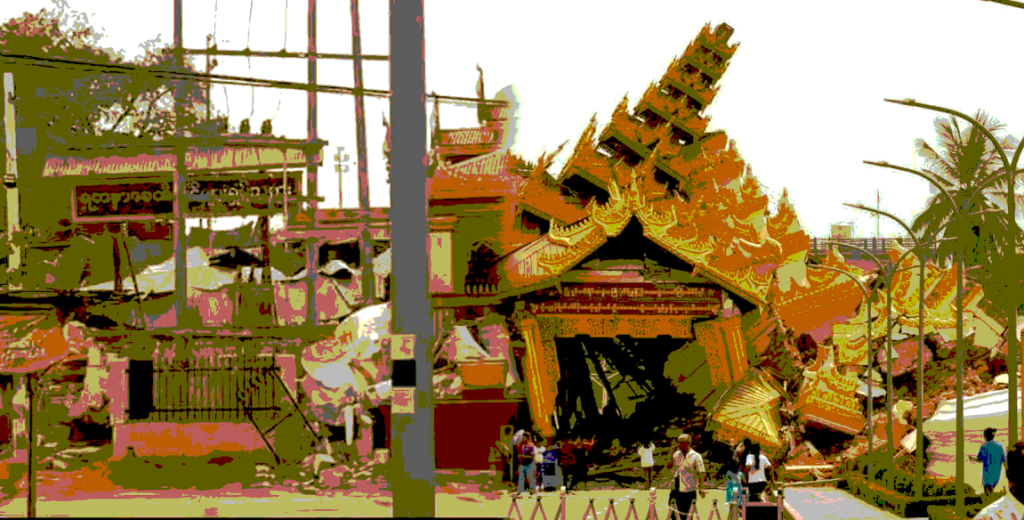Myanmar Spring Chronicle – March 30 Scene
MoeMaKa, March 31, 2025
A Natural Disaster in the Midst of a Civil War
Cities such as Mandalay, Sagaing, Nay Pyi Taw, Pyin Oo Lwin, Kyaukse, Taungoo, Pyawbwe, Nyaung Shwe, and Inle are located near the earthquake fault line and epicenter, and they are among the worst-affected areas by the quake.
Most of these cities are either experiencing civil war directly or are located in regions impacted by it. For example, while Mandalay itself hasn’t seen active fighting, it has become a temporary refuge for tens or even hundreds of thousands of people displaced by the conflict. On the other hand, Sagaing, just across the river from Mandalay, is a city where fighting occurs just beyond its immediate boundaries.
Due to the ongoing conflict, roads and travel routes are littered with security checkpoints and restrictions. Civilians, caught between armed clashes, have been trying to survive under immense pressure, struggling to maintain livelihoods. These are areas where healthcare systems were already weak, with shortages of medicines, medical personnel, and budgets. Transportation is difficult, and now, a major earthquake has struck under these already strained conditions. In regions where trust in the ruling authority is low, people are now facing a once-in-a-lifetime natural disaster.
While there has been a lot of media attention on Mandalay, a city of 1.5 million people, there is very little reporting on Sagaing, home to over 300,000 people.
Sagaing has many damaged and collapsed homes and religious buildings, and there are still many trapped survivors. But most of the media focus has been on Mandalay, which has five times the population of Sagaing. The destruction and casualties in Mandalay have been quickly and widely shared on social media. However, similar images and reports from Sagaing are far fewer.
Some photos and videos have started to emerge showing collapsed buildings and debris along the Mandalay-Monywa highway, which cuts through Sagaing. Buddhist monasteries, nunneries, and pagodas have collapsed. Some mosques used by the Muslim community have also been destroyed. Religious schools and monastic institutions were especially hard hit, resulting in many deaths. Sagaing lies along a ridge filled with these religious buildings, many of which have collapsed or trapped people beneath them.
Yet, there’s been no news of rescue aid—either from the military government or from international rescue groups—reaching Sagaing. Prior to the earthquake, the military junta’s control in Sagaing was limited mainly to the city center. Areas along the river roads from Sagaing to Mingun and Sagaing to Monywa are frequently sites of skirmishes and clashes between resistance forces and the military.
The Mingun bell, Mingun pagoda, and the Myatheintan Pagoda, once popular tourist sites, are now frequently in zones attacked or patrolled by the junta’s forces.
Given this situation, the lack of rescue and relief in Sagaing appears to be partly due to the region being a resistance stronghold and partly due to the junta’s perception that local people support the opposition forces. This leads to a disturbing conclusion: the junta may be deliberately neglecting aid to certain areas based on perceived political alignment.
The scenes coming out of Sagaing in photos and videos are heartbreaking. Social media is filled with urgent pleas for help from locals, and it is truly devastating to witness.
Under the heat of March, even those who are not trapped are struggling to find clean water, food, or shelter. For those still trapped under debris, every passing hour is critical. Time is running out.
When people face the same natural disaster but are treated differently based on political alignment, it reflects inhumane behavior and adds to the record of the junta’s cruelty.
In recent days, there have been proposals that both armed sides should work together on rescue operations and possibly even end the civil conflict through cooperation in the face of a natural disaster. But the military regime, which holds state power, does not appear to have any such mindset. That absence of willingness dashes any hopes of peace. If, even in these life-and-death moments, the junta refuses to shift its stance, then the hope for peace remains a distant dream.

